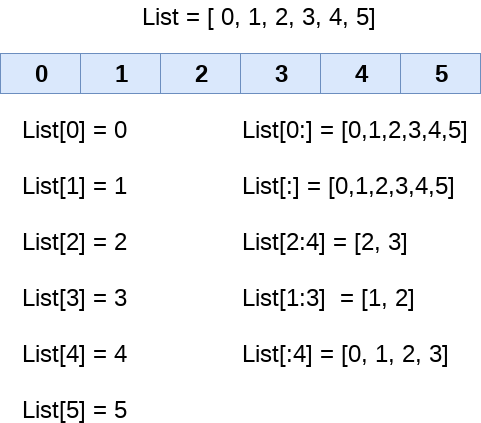实现python中的List以存储各种类型数据的序列。但是,python包含六种能够存储序列的数据类型,但最常见和可靠的类型是列表。
列表可以定义为值集合或不同类型的项目。列表中的项目用逗号(,)分隔,并用方括号[]括起来。
列表可以定义如下:
L1 = ["John", 102, "USA"] L2 = [1, 2, 3, 4, 5, 6] L3 = [1, "Ryan"]
如果我们尝试打印L1,L2和L3的类型,那么它将成为一个列表。
让我们考虑一个合适的例子来定义一个列表并打印它的值。
emp = ["John", 102, "USA"]
Dep1 = ["CS",10];
Dep2 = ["IT",11];
HOD_CS = [10,"Mr. Holding"]
HOD_IT = [11, "Mr. Bewon"]
print("printing employee data...");
print("Name : %s, ID: %d, Country: %s"%(emp[0],emp[1],emp[2]))
print("printing departments...");
print("Department 1:\nName: %s, ID: %d\nDepartment 2:\nName: %s, ID: %s"%(Dep1[0],Dep2[1],Dep2[0],Dep2[1]));
print("HOD Details ....");
print("CS HOD Name: %s, Id: %d"%(HOD_CS[1],HOD_CS[0]));
print("IT HOD Name: %s, Id: %d"%(HOD_IT[1],HOD_IT[0]));
print(type(emp),type(Dep1),type(Dep2),type(HOD_CS),type(HOD_IT));输出:
printing employee data... Name : John, ID: 102, Country: USA printing departments... Department 1: Name: CS, ID: 11 Department 2: Name: IT, ID: 11 HOD Details .... CS HOD Name: Mr. Holding, Id: 10 IT HOD Name: Mr. Bewon, Id: 11 <class 'list'> <class 'list'> <class 'list'> <class 'list'> <class 'list'>
列出索引和拆分
索引的处理方式与字符串的处理方式相同。可以使用切片运算符[]访问列表的元素。
索引从0开始并转到长度 - 1.列表的第一个元素存储在第0个索引处,列表的第二个元素存储在第1个索引处,依此类推。
请参考下图:

与其他语言不同,python为我们提供了使用否定索引的灵活性。负指数从右侧计算。列表的最后一个元素(最右边)具有索引-1,其相邻的左元素出现在索引-2处,依此类推,直到遇到最左边的元素。

更新列表值
列表是python中最通用的数据结构,因为它们是不可变的,并且可以使用切片和赋值运算符更新它们的值。
Python还为我们提供了append()方法,该方法可用于向字符串添加值。
请考虑以下示例来更新列表中的值。
List = [1, 2, 3, 4, 5, 6] print(List) List[2] = 10; print(List) List[1:3] = [89, 78] print(List)
输出:
[1,2,3,4,5,6] [1,2,10,4,5,6] [1,89,78,4,5,6]
也可以使用del关键字删除列表元素。如果我们不知道要从列表中删除哪个元素,Python还为我们提供了remove()方法。
请根据以下示例来学习删除列表元素。
List = [0,1,2,3,4] print(List) del List[0] print(List) del List[3] print(List)
输出:
[0,1,2,3,4] [1,2,3,4] [1,2,3]
Python列表操作
串联(+)和重复(*)运算符的工作方式与处理字符串的方式相同。
让我们看看列表如何处理运算符:
假设列表 l1 = [1, 2, 3, 4], l2 = [5, 6, 7, 8]
| 操作符 | 描述 | 示例 |
| 重复 | 重复运算符使列表元素能够重复多次。 | L1 * 2 = [1,2,3,4,1,2,3,4] |
| 级联 | 它连接运算符两侧提到的列表。 | l1 + l2 = [1,2,3,4,5,6,7,8] |
| 籍 | 如果特定列表中存在特定项目,则返回true,否则返回false。 | print(l1中的2)打印True。 |
| 迭代 | for循环用于迭代列表元素。 | for i in l1: 输出: 1 2 3 4 |
| 长度 | 它用于获取列表的长度 | len(l1) = 4 |
迭代列表
可以使用for-in循环迭代列表。包含四个字符串的简单列表可以如下迭代。
List = ["John", "David", "James", "Jonathan"] for i in List: #i will iterate over the elements of the List and contains each element in each iteration. print(i);
Output:
John David James Jonathan
将元素添加到列表中
Python提供了append()函数,我们可以使用它来向列表添加元素。但是,append()方法只能将值添加到列表的末尾。
考虑以下示例,其中,我们从用户获取列表的元素并在控制台上打印列表。
l =[];
n = int(input("Enter the number of elements in the list")); #Number of elements will be entered by the user
for i in range(0,n): # for loop to take the input
l.append(input("Enter the item?")); # The input is taken from the user and added to the list as the item
print("printing the list items....");
for i in l: # traversal loop to print the list items
print(i, end = " ");Output:
Enter the number of elements in the list 5 Enter the item?1 Enter the item?2 Enter the item?3 Enter the item?4 Enter the item?5 printing the list items.... 1 2 3 4 5
从列表中删除元素
List = [0,1,2,3,4]
print("printing original list: ");
for i in List:
print(i,end=" ")
List.remove(0)
print("\nprinting the list after the removal of first element...")
for i in List:
print(i,end=" ")Output:
printing original list: 0 1 2 3 4 printing the list after the removal of first element... 1 2 3 4
Python列表内置函数
Python提供了以下内置函数,可以与列表一起使用。
| SN | 函数 | 描述 |
| 1 | cmp(list1, list2) | 它比较了两个列表的元素。 |
| 2 | len(list) | 它用于计算列表的长度。 |
| 3 | max(list) | 它返回列表的最大元素。 |
| 4 | min(list) | 它返回列表的最小元素。 |
| 5 | list(seq) | 它将任何序列转换为列表。 |
Python List内置方法
| SN | 函数 | 描述 |
| 1 | list.append(OBJ) | 对象obj表示的元素被添加到列表中。 |
| 2 | list.clear() | 它会从列表中删除所有元素。 |
| 3 | List.copy() | 它返回列表的浅表副本。 |
| 4 | list.count(OBJ) | 它返回列表中指定对象的出现次数。 |
| 5 | list.extend(SEQ) | 对象seq表示的序列扩展到列表。 |
| 6 | list.index(OBJ) | 它返回对象出现的列表中的最低索引。 |
| 7 | list.insert(index,obj) | 该对象将插入到指定索引的列表中。 |
| 8 | list.pop(OBJ =列表[-1]) | 它删除并返回列表的最后一个对象。 |
| 9 | list.remove(OBJ) | 它从列表中删除指定的对象。 |
| 10 | list.reverse() | 它颠倒了清单。 |
| 11 | list.sort([FUNC]) | 如果给定,它使用指定的比较函数对列表进行排序。 |

 第1章 Python简介
第1章 Python简介